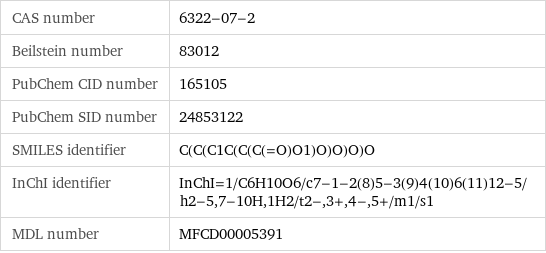Input interpretation

gulonolactone
Chemical names and formulas
![formula | C_6H_10O_6 name | gulonolactone IUPAC name | (3R, 4S, 5S)-5-[(1R)-1, 2-dihydroxyethyl]-3, 4-dihydroxy-2-tetrahydrofuranone alternate names | (3R, 4S, 5S)-5-[(1R)-1, 2-dihydroxyethyl]-3, 4-dihydroxy-oxolan-2-one | (3R, 4S, 5S)-5-[(1R)-1, 2-dihydroxyethyl]-3, 4-dihydroxyoxolan-2-one | (3R, 4S, 5S)-5-[(1R)-1, 2-dihydroxyethyl]-3, 4-dihydroxy-tetrahydrofuran-2-one | D-(-)-gulono-1, 4-lactone | D-gulono-1, 4-lactone | D-gulono-g-lactone | D-gulonolactone | D-gulono γ-lactone mass fractions | C (carbon) 40.5% | H (hydrogen) 5.66% | O (oxygen) 53.9%](../image_source/3c0bbbb44045e9b0aa36c91d99985fbf.png)
formula | C_6H_10O_6 name | gulonolactone IUPAC name | (3R, 4S, 5S)-5-[(1R)-1, 2-dihydroxyethyl]-3, 4-dihydroxy-2-tetrahydrofuranone alternate names | (3R, 4S, 5S)-5-[(1R)-1, 2-dihydroxyethyl]-3, 4-dihydroxy-oxolan-2-one | (3R, 4S, 5S)-5-[(1R)-1, 2-dihydroxyethyl]-3, 4-dihydroxyoxolan-2-one | (3R, 4S, 5S)-5-[(1R)-1, 2-dihydroxyethyl]-3, 4-dihydroxy-tetrahydrofuran-2-one | D-(-)-gulono-1, 4-lactone | D-gulono-1, 4-lactone | D-gulono-g-lactone | D-gulonolactone | D-gulono γ-lactone mass fractions | C (carbon) 40.5% | H (hydrogen) 5.66% | O (oxygen) 53.9%
Lewis structure

Draw the Lewis structure of gulonolactone. Start by drawing the overall structure of the molecule, ignoring potential double and triple bonds: Count the total valence electrons of the carbon (n_C, val = 4), hydrogen (n_H, val = 1), and oxygen (n_O, val = 6) atoms: 6 n_C, val + 10 n_H, val + 6 n_O, val = 70 Calculate the number of electrons needed to completely fill the valence shells for carbon (n_C, full = 8), hydrogen (n_H, full = 2), and oxygen (n_O, full = 8): 6 n_C, full + 10 n_H, full + 6 n_O, full = 116 Subtracting these two numbers shows that 116 - 70 = 46 bonding electrons are needed. Each bond has two electrons, so in addition to the 22 bonds already present in the diagram add 1 bond. To minimize formal charge oxygen wants 2 bonds and carbon wants 4 bonds. Identify the atoms that want additional bonds and the number of electrons remaining on each atom: Fill in the 1 bond by pairing electrons between adjacent highlighted atoms: Answer: | |
3D structure

3D structure
Basic properties

molar mass | 178.14 g/mol phase | solid (at STP) melting point | 185 °C boiling point | 396 °C density | 1.652 g/cm^3 solubility in water | very soluble
Units

Solid properties (at STP)

density | 1.652 g/cm^3
Units

Chemical identifiers

CAS number | 6322-07-2 Beilstein number | 83012 PubChem CID number | 165105 PubChem SID number | 24853122 SMILES identifier | C(C(C1C(C(C(=O)O1)O)O)O)O InChI identifier | InChI=1/C6H10O6/c7-1-2(8)5-3(9)4(10)6(11)12-5/h2-5, 7-10H, 1H2/t2-, 3+, 4-, 5+/m1/s1 MDL number | MFCD00005391
NFPA label

NFPA label

NFPA health rating | 1 NFPA fire rating | 0 NFPA reactivity rating | 0